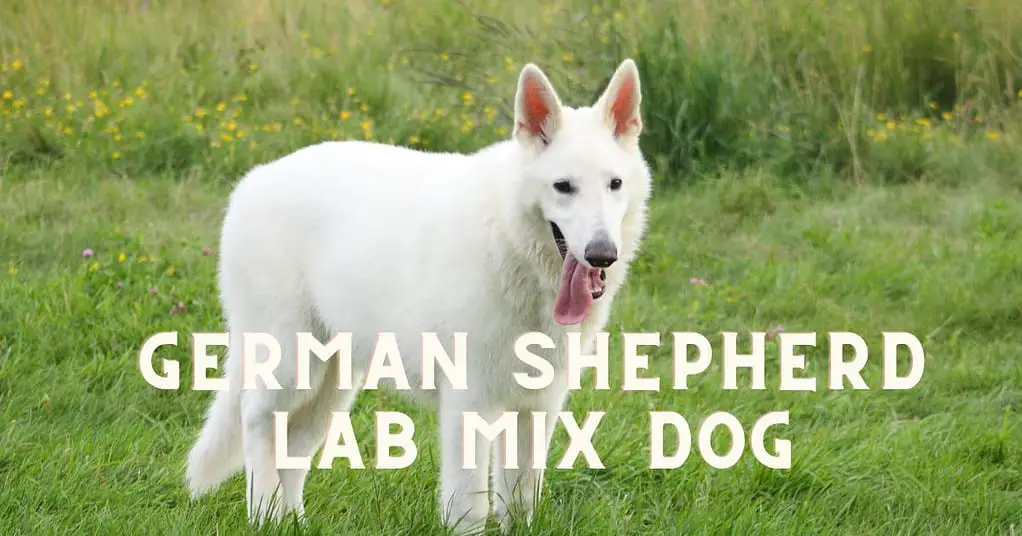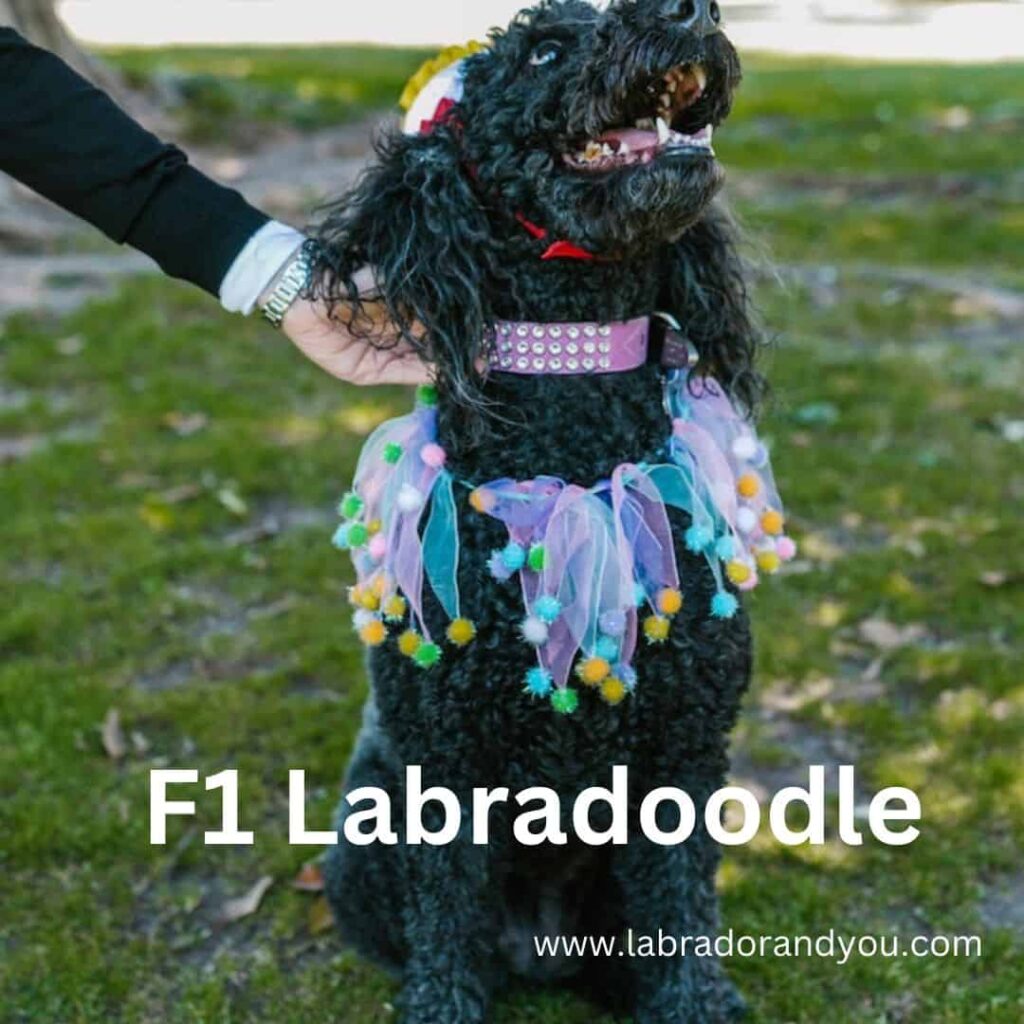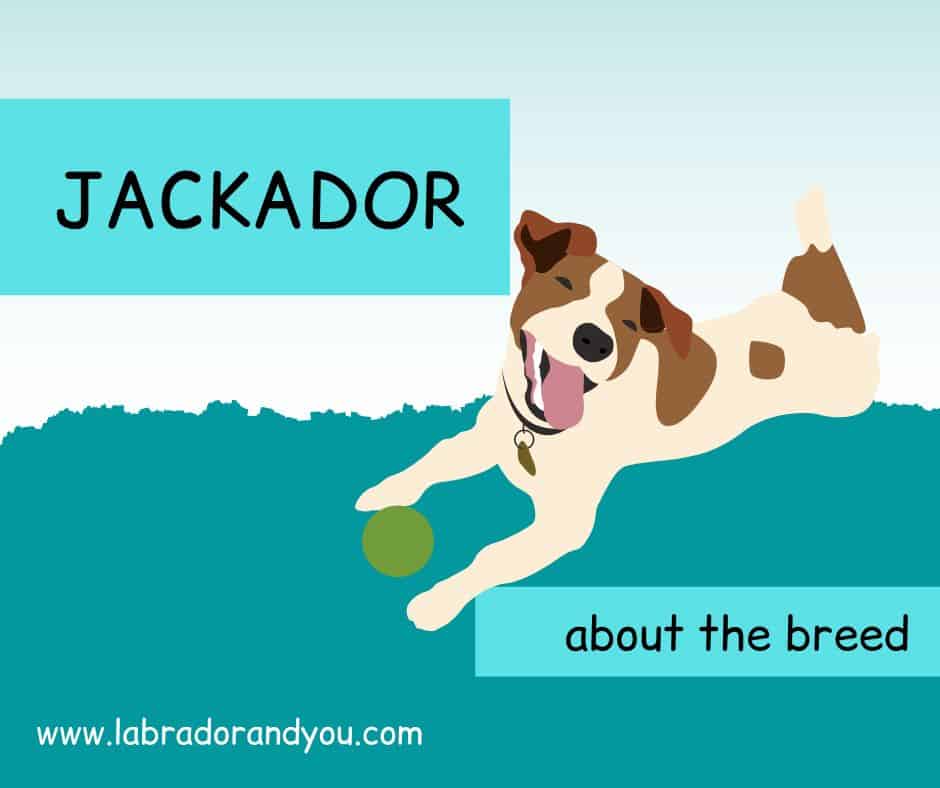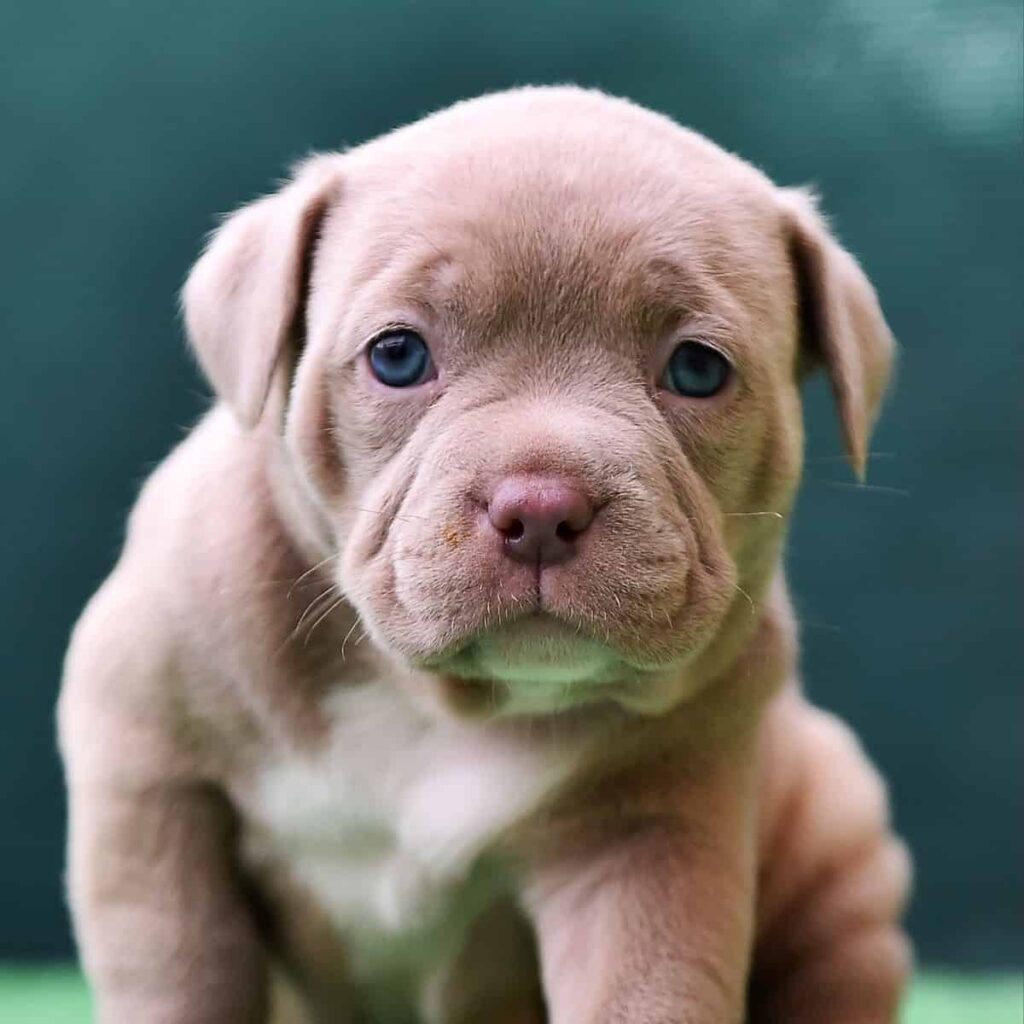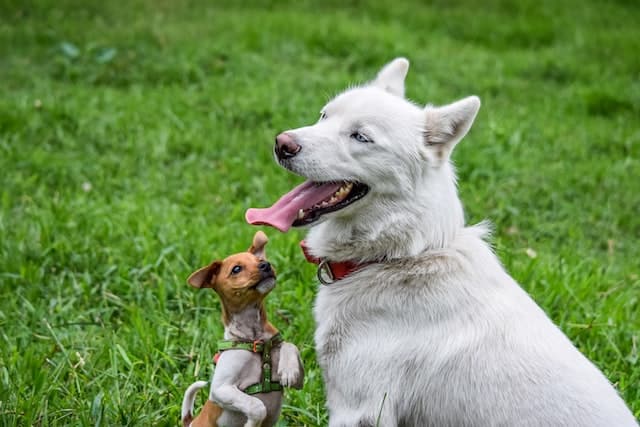“Hypoallergenic” refers to a dog breed less likely to provoke an allergic response in humans. Hypoallergenic dogs tend to produce fewer allergens than other breeds, and they also tend to have low-shedding coats. So are labradoodles hypoallergenic?
The hypoallergenic dogs Labradoodle is believed to shed less dander. They are a cross between a Labrador Retriever and a Poodle. However, Labradoodles are not hypoallergenic. Only the Australian version is.
You can contract allergies from them; however, managing their shedding is easier. Allergies that can affect Labradoodles include environmental, food, flea, contact, and inhalant allergies.
What Is The Meaning of Hypoallergenic Dog?
Millions worldwide have always had a deep affection for pets, cherishing them uniquely and meaningfully. For many dog owners, pets are family. However, for people with allergies, this can be a real challenge.
The Asthma and Allergy Foundation of America conducted research. The reports state that cats and dogs can trigger allergic reactions in around 30% of individuals with allergies.
When you classify a dog as hypoallergenic, they are less likely to provoke an allergic response in humans. It is because they produce fewer allergens than other breeds.
These dogs tend to have a low shedding coat, meaning Labradoodles do shed but less, causing less hair to float. It reduces the number of allergens that a person is exposed to.
No dog breed is entirely hypoallergenic. All dogs produce allergens due to proteins in their skin, saliva, and urine. The degree to which a dog can trigger allergies in humans depends on several factors, including the individual’s sensitivity.
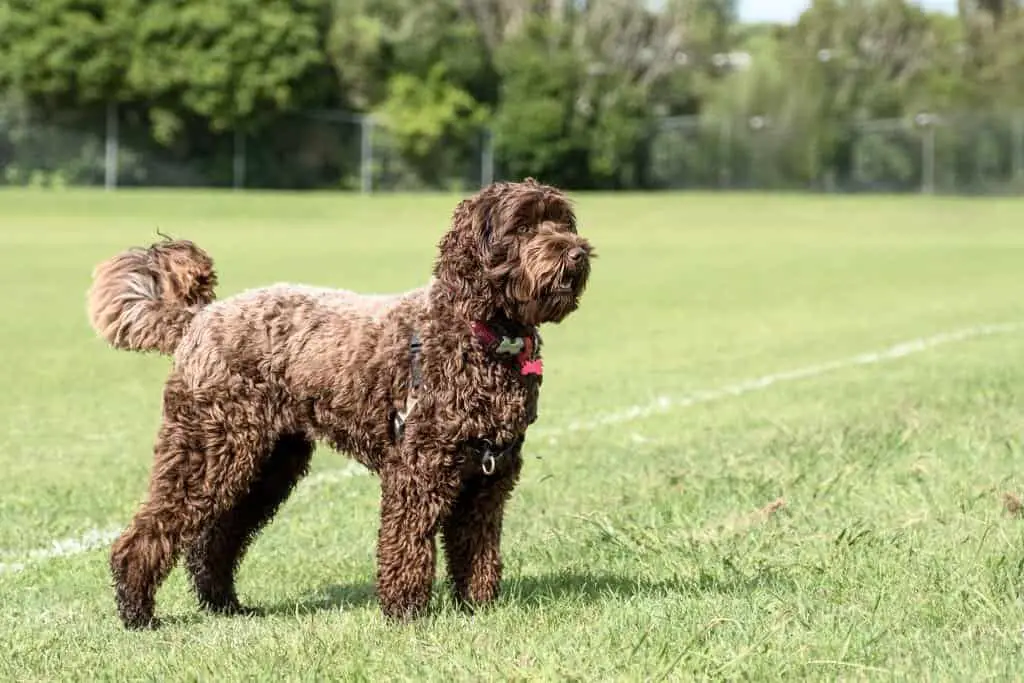
Can my Labradoodle Develop Allergies? Types?
Labradoodles can cause allergic reactions in many labradoodle owners.
Environmental Allergies
A labradoodle’s exposure to allergens in its surroundings can cause allergies. These allergens include pollen, mold, dust mites, and other airborne particles. Environmental allergies are also commonly known as atopic dermatitis or canine atopy.
Food Allergies
Food allergies occur when a dog’s immune system overreacts to certain proteins found in dog food. Common allergens include beef, chicken, dairy, and wheat. Food allergies can be challenging to diagnose, as the symptoms can be similar to other allergies.
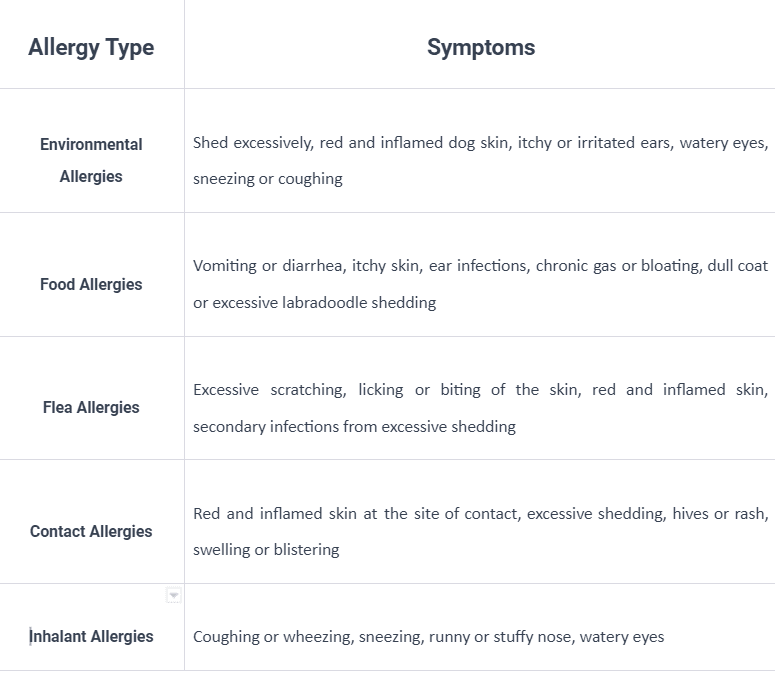
Flea Allergies
Flea allergies are allergic reactions when fleas bite a labradoodle puppy. The bites can cause a severe reaction in some dogs, resulting in intense itching and discomfort. This type of allergy is more common in dogs that spend much time outside or live in areas with high flea populations.
Contact Allergies
Exposure to a substance that triggers an allergic reaction triggers contact allergies in Labradoodles. Common allergens include certain plants, cleaning products, and materials such as wool or rubber.
Inhalant Allergies
Inhalant or respiratory allergies occur when a dog inhales allergens such as dust or pollen. These allergens can cause inflammation and irritation in the respiratory tract, leading to symptoms such as coughing and wheezing.
The Labradoodle’s Ancestry: Poodle With Labrador Retriever
The Labradoodle first gained widespread popularity in the 1980s when Wally Conron, a dog breeder from Australia, bred it. Conron attempted to create a hypoallergenic service dog for a blind woman whose husband was allergic to dogs. Hence these dogs were specifically bred for this purpose.
He was breeding Labrador Retriever with a standard poodle parent, resulting in a litter of intelligent, friendly puppies with a low-shedding coat.
Conron named the crossbreed the “Labradoodle.” It quickly gained popularity as a family pet and a hypoallergenic guide dog. However, the Labradoodle’s ancestry goes back much further than the 1980s.
Labrador Retrievers
Originally bred in St. John, the capital of Newfoundland, in the early 1700s, people initially referred to Labrador Retrievers as “St. John’s.”
Labrador Retrievers earned their name from their original purpose, which was retrieving fish from the shores of Newfoundland for their dog owner. However, in 1880, they nearly faced extinction due to increased taxes and government-imposed regulations.
Fortunately, Labrador Retrievers were reintroduced in the 1920s when they made their way to the United States. The breed’s popularity surged after World War II and gained traction throughout the 1920s.
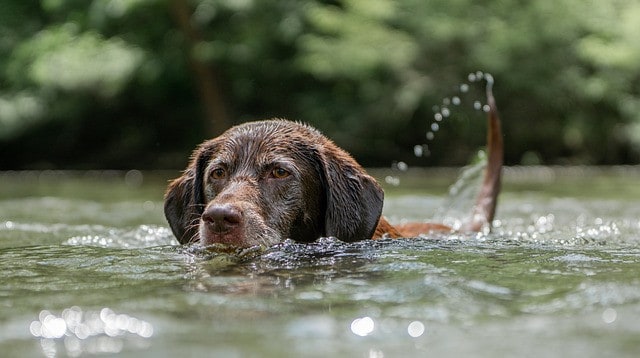
The Poodle
The Poodle breed was first mentioned in 1555 by Swiss scientist Conrad Gessner. Some experts claim that its ancestor is a pastoral dog, while others believe it comes from the English “water dog,” used to bring water to wild animals.
The Poodle probably emerged from crossbreeding between the two original breeds. It is supported by its two types of fur – curly and lace – and it’s excellent character traits that have been preserved to this day.
In the 18th century, the Poodle was famous as an elegant companion. By the 19th century, it had become a luxury dog in Britain and had already taken on its current shape.
In 1876, it was classified as an independent breed. The Poodle made its way from Europe to America in 1887.
The Crossbreeding of the Labrador Retriever and Poodle
Wally Conron spent two years and 33 unsuccessful attempts to find the right Poodle for the job. Despite rejecting many poodles with various issues, he still couldn’t find a suitable one.
Desperate, he crossbreeds a standard poodle with one of their best labradors. However, they only produced only three puppies. They sent puppy coat and saliva samples to a Hawaiian couple who found one of the samples to be allergy-free.
In 1989, the new designer dog news spread nationally and internationally. It opened up a whole new dog world for countless people who thought they could never enjoy the pleasure of having a pet dog.
Sultan, the non-allergic puppy, went to Hawaii amid intense media coverage as the world’s first labradoodle.
The Labradoodle Today
The Labradoodle remains a popular breed for families and individuals who want a bright, friendly, and hypoallergenic pet.
The Labradoodle’s popularity has also led to the creation of other “Doodle” breeds, such as the Goldendoodle and the Bernedoodle. Since 1998, the Australian Labradoodle Association has been actively promoting and safeguarding the breed.
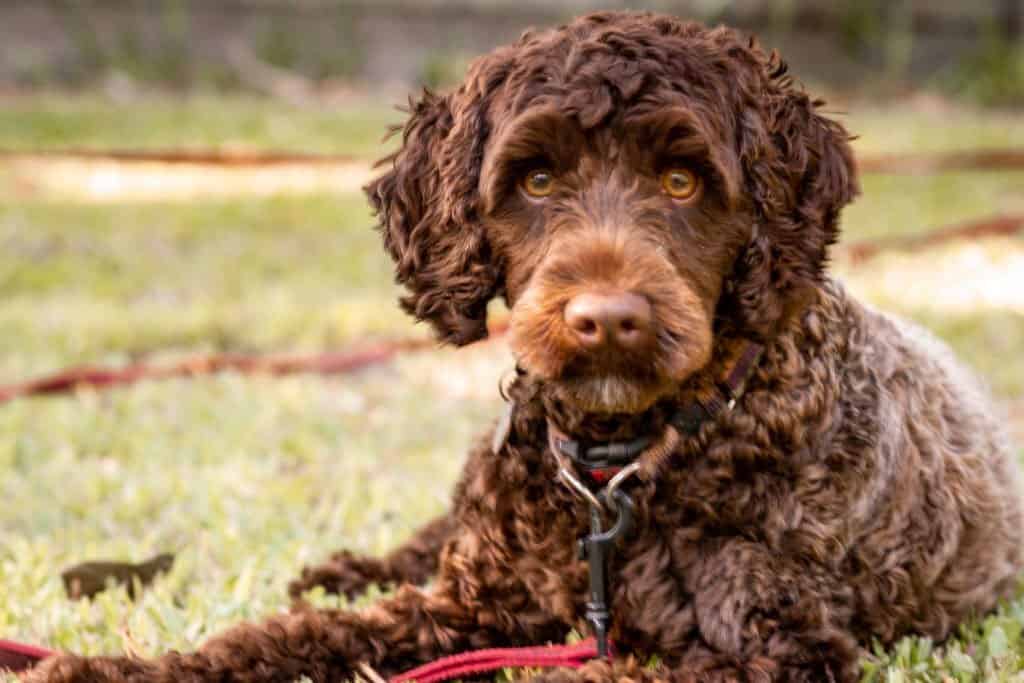
How to Choose an Allergy-Friendly Hypoallergenic Dogs Labradoodle?
Here’s what you need to know about F1, F1B, and F2 Labradoodles to make the best decision for you and your family.
F1 Labradoodle (First Generation Labradoodles)
The F1 Labradoodle is the first-generation crossbreed of purebred dogs – Poodle and Labrador Retriever. These dogs have a 50/50 mix of each breed and are the most unpredictable in coat type and labradoodle shedding.
Their fur can range from curly to wavy. The level of Labradoodles’ shed and hair loss can vary from minimal to moderate. This shedding dog is ideal for people with mild allergies but not for those with severe allergies.
F1B Labradoodle (2nd Generation)
The F1B Labradoodle is a second-generation crossbreed of a Labradoodle and a Poodle. These labradoodle offspring are 75% Poodle and 25% Labrador Retriever.
These dogs have a more consistent hypoallergenic coat. F1B Labradoodles are ideal for people with moderate to severe allergies.
F2 Labradoodle (3rd Generation)
The F2 Labradoodle is a third-generation crossbreed of two F1B Labradoodles or an F1B labradoodle and a poodle. These dogs have a more consistent coat that is usually curly and hypoallergenic. They are 87% Poodle and 13% Labrador. F2 Labradoodles are ideal for people with moderate to severe allergies.
How to choose a labradoodle puppy?
If you’re considering a labradoodle, here are some factors to consider:
- Meet the parents: Spend time with the Labrador Retriever and Poodle parent to understand their temperaments and personalities. Observing a Labradoodle’s parents can provide insight into what you can anticipate from the breed.
- Observe their coats: Look at the parents’ coats to see if Labradoodles shed a lot or have hypoallergenic qualities. By examining the coats of a Labradoodle’s parents, you can determine the type of coat your labradoodle will likely possess.
- Consider the breeder: Make sure you choose a reputable breeder who has health-tested their dogs and is knowledgeable about these dog breeds. A good breeder can help you find the right labradoodle for your needs.
What Causes You to Be Allergic to Labradoodles?
Despite their reputation, some people still find themselves experiencing allergic reactions when around Labradoodles.
Pet Dander
One of the leading causes of shedding dog allergies is dander. Dander is the dead skin flakes that Labradoodles shed regularly. Even if it has a low shedding coat, still labradoodles shed some dander.
Saliva
Another cause of Labradoodle allergies is saliva. When dogs lick their fur, their saliva dries on the hair, leaving behind proteins that can trigger an allergic reaction. Labradoodles love to lick themselves, leaving traces of saliva on their coats.
The saliva contains a protein known as Can F1, which has the potential to cause an allergic response in certain individuals.
Urine
When a dog urinates, proteins in the urine can become airborne, causing allergic symptoms in some people.
If you are allergic to dog urine proteins, you may experience symptoms like sneezing, itching, and watery eyes around a Labradoodle.
Breed Mix
The amount of allergens a Labradoodle has depends on the dog’s genetics. Some Labradoodles may produce more allergens than other dogs, making them more likely to trigger an allergic reaction.
Pollen
Labradoodles, like all dogs, enjoy spending time outdoors. When they do, they can pick up pollen on their fur, triggering an allergic reaction in some people.
Being around a Labradoodle outside can cause symptoms like sneezing, runny nose, and itchy eyes if you are allergic to pollen.
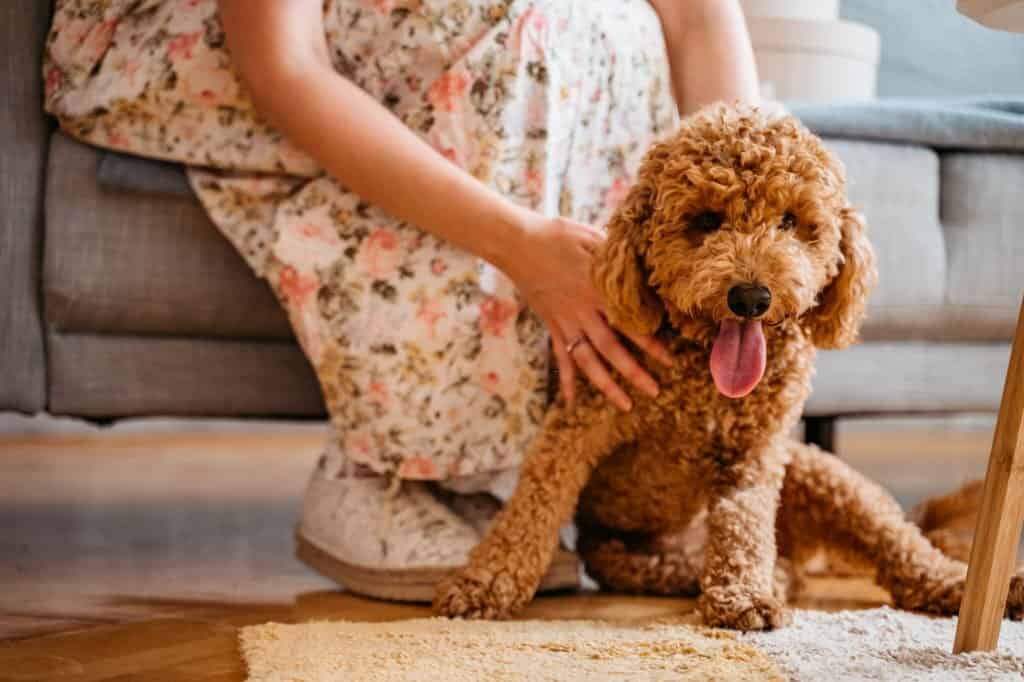
How To Reduce Pet Allergies From Hypoallergenic Dogs Labradoodle?
Here are eight practical tips on reducing your allergy symptoms from Labradoodles.
1. Regular Grooming For Labradoodle.
Regular grooming is a crucial step in managing your allergy symptoms. Grooming your labradoodle regularly will help reduce the amount of hair the labradoodle shed and saliva.
- Brush your labradoodle at least once a week using a slicker brush. It will help remove loose hair and debris from their coat.
- Bathe your labradoodle every four to six weeks using a hypoallergenic shampoo.
- Avoid over-bathing, which can dry out the dog’s skin and increase labradoodle shedding.
- Trim your labradoodle’s hair regularly, as longer hair can trap more allergens.
2. Install an Air Filter & Air Cleaner
Indoor air quality is essential in managing your allergy symptoms from Labradoodles. By installing an air filter and cleaner, you can reduce the amount of labradoodle shed and allergens in the air.
- Look for an air filter with a HEPA (High-Efficiency Particulate Air) filter. HEPA filters can remove up to 99.97% of airborne particles, including dander and pollen. Be dander free.
- Choose an air cleaner with a UV-C light, which can kill bacteria, viruses, and mold spores.
3. Consider Non-Carpeted Flooring
Carpet can trap labradoodle shed and allergens, making it difficult to manage your allergy symptoms. Consider replacing your carpet with non-carpeted, hardwood, or tile flooring options.
- Hardwood flooring
- Tile flooring
- Laminate flooring
- Vinyl flooring
4. Cover the Couch with a Blanket
Your couch can also trap labradoodle sheds and allergens, making it difficult to manage your allergy symptoms. Covering your couch with a blanket can minimize dander and allergens on the surface.
- Choose a washable blanket that can be laundered frequently.
- Select a blanket that matches the decor of your living room.
5. Restrict Access to Your Bedroom
Your bedroom should be a sanctuary, free from allergens and irritants. Restricting access to your bedroom can help reduce the amount of dogs shed and allergens in the air. Here are some tips for keeping your bedroom allergen-free:
- Keep your labradoodle dog out of your bedroom.
- Wash your bedding and pillows frequently in hot water.
- Consider using dust mite covers on your mattress and pillows.
- Practise positive reinforcement.
6. Wear “Pet-Specific” Clothes
Wearing “pet-specific” clothes can help reduce the amount of dander and allergens on your clothing. Here are some tips for choosing pet-specific clothes:
- Choose clothes that are made from Labradoodles hypoallergenic materials.
- Wear a lab coat or smock when grooming your labradoodle dog.
7. Wash Your Hands Frequently
Washing your hands frequently reduces shedding on your skin.
- Use warm water and soap when washing your hands.
- Ensure you wash your hands before and after interacting with your labradoodle dog to maintain proper hygiene.
8. Use Medicinal Remedies
Sometimes, you may need to use medicinal remedies to manage your allergy symptoms from Labradoodles. Antihistamines can help relieve sneezing, itching, and runny nose. Decongestants, which can help reduce nasal congestion.
Nasal sprays can help relieve nasal symptoms. Allergy shots can help build immunity to allergens over time.
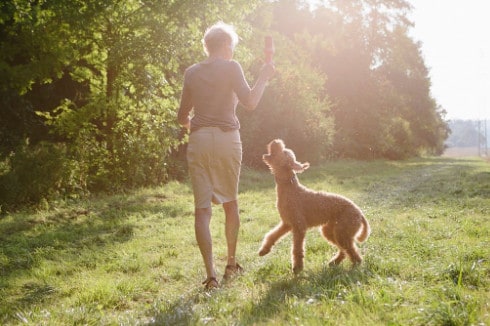
How To Groom Your Labradoodle To Be More Allergy friendly?
Yes, they shed. Here are classic grooming steps for your Labradoodles
Step 1: Brush Your Hypoallergenic Labradoodle’s Coat
Brushing is essential as it helps remove tangles and mats. It also distributes natural oils throughout the adult coat. To brush your dog’s coat properly, follow these steps:
- Start using a slicker brush to remove loose fur from your dog’s coat.
- Use a metal comb to work through any tangles and mats gently. Be careful not to pull on your labradoodles fur, as this can be painful.
- Once you have worked through the tangles, use a bristle brush to smoothen the coat and distribute the natural oils.
Step 2: Trim Your Hypoallergenic Labradoodle’s Coat
Trimming is another crucial aspect of grooming.
- Use clippers to trim the dog’s hair around the face, ears, and paws.
- Use scissors to cut the hair around your dog’s tail and any other areas that you need tidy up.
- Be careful when trimming around your dog’s face and ears, as these areas are sensitive and require a gentle touch.
Step 3: Clean Your Hypoallergenic Labradoodle’s Ears
Cleaning your dog’s ears promotes ear health and prevents infections.
- To remove any dirt or debris from your dog’s ear, use a damp cloth to wipe the inside of their ear gently.
- Use an ear-cleaning solution to clean the ear canal. Follow the directions on the product carefully.
- Dry your dog’s ear thoroughly with a clean, dry cloth.
- It is essential to be gentle to avoid discomfort or injury to the ear canal.
Step 4: Bathe Your Hypoallergenic Labradoodle
Bathing your Hypoallergenic Labradoodle is another essential aspect of their grooming routine. Here are some tips to help you cleanse your dog effectively:
- Use a mild dog shampoo that is designed specifically for Hypoallergenic Labradoodles.
- Wet your dog’s coat thoroughly with warm water.
- Apply the shampoo and work it into a lather.
- Rinse your labradoodle puppy thoroughly with warm water.
- Use a clean, dry towel to dry your dog’s coat.
Step 5: Trim Your Hypoallergenic Labradoodle’s Nails
Long nails can cause discomfort and make your dog walk awkwardly.
- Use sharp nail clippers to trim your dog’s nails.
- When trimming your dog’s nails, don’t cut the quick. It is the pink part of the nail containing blood vessels and nerves.
- If you accidentally cut the quick, use styptic powder or cornstarch to stop the bleeding.
If you need help trimming your dog’s nails, ask your professional groomer for help.
Step 6: Feeding a Balanced Diet
A balanced diet ensures your dog receives all the necessary vitamins and minerals to promote healthy skin and hair growth.
- Consult your vet to determine the appropriate diet for your Labradoodle based on age, weight, and activity level.
- Feed your dog high-quality food containing lean protein, vegetables, and fruits.
- To prevent digestive issues and obesity in your dog, it’s best to refrain from feeding them with table scraps.
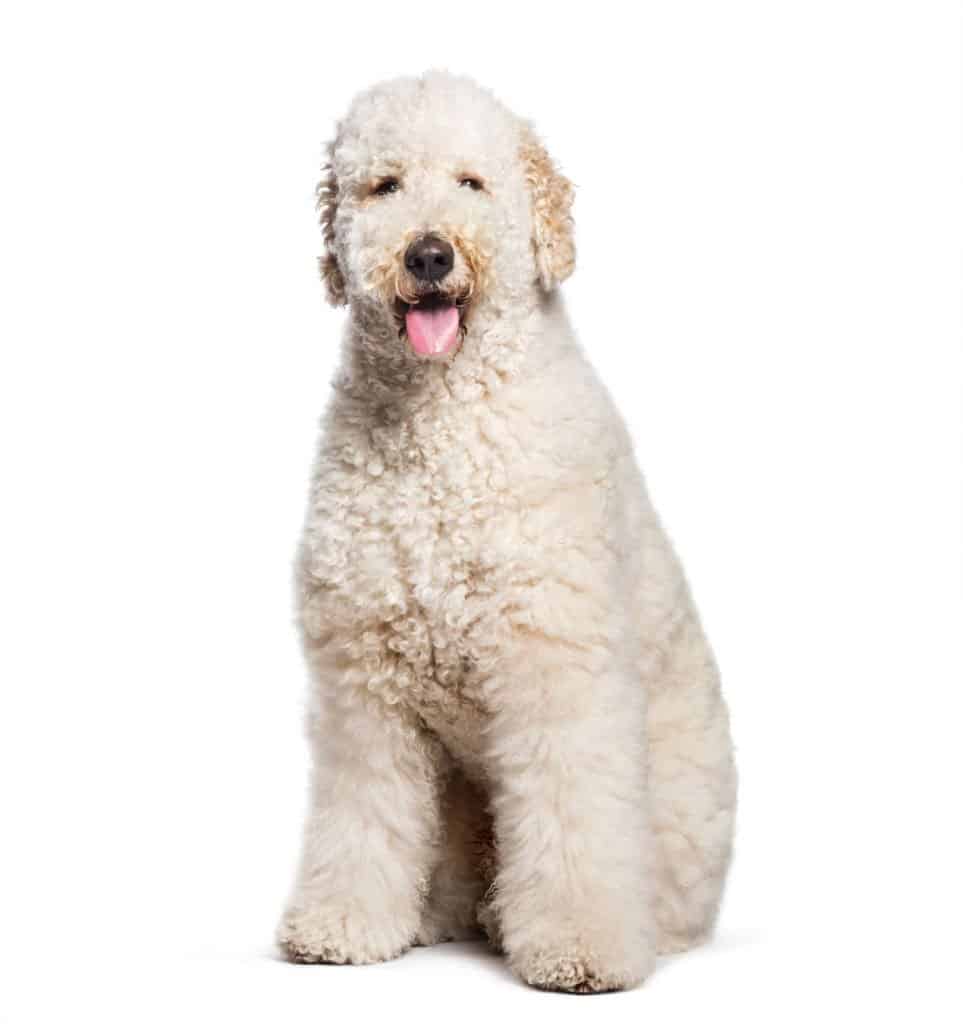
Types of Labradoodle coats
Wool Coat
A wool coat is the most hypoallergenic type of Labradoodle coat. It has tight, springy curls that give it a poodle-like appearance. Curly coats are very low shedding, making them ideal for people with allergies.
Fleece Poodle Coat
A fleece coat is a combination of a wavy and curly coat. It has a soft, plush texture that is very similar to fleece. Fleece coats are low shedding and hypoallergenic, making them a popular choice for people with allergies.
Hair Coat
A hair coat is the least common type of Labradoodle coat. It is typically a straight coat with a wiry texture similar to a terrier. It is a low-shedding coat but requires more maintenance than other coats, including regular brushing and trimming.
Least Allergenic Dogs You’d Want To Know
Let’s explore the least allergenic dog breeds and discuss what makes them suitable for people with allergies.
Poodle
Poodles are one of the least allergenic dog breeds. They have curly, low-shedding coats that trap dander and other allergens. They have less dander. Poodles come in three sizes: Standard, Miniature, and Toy. They are brilliant, loyal, and trainable dogs.
Bichon Frise
Bichon Frises have curly, hypoallergenic coats that don’t shed much dog hair. They are small dogs that are playful and friendly, making them great family pets.
Portuguese Water Dog
Water Dog Portuguese Water Dogs have wavy, hypoallergenic coats that don’t shed. People initially bred them to help fishermen in Portugal, so they are highly active and enjoy swimming.

Hypoallergenic Dogs: Allergy Friendly
Maltese
Maltese dogs have silky and straight coat that doesn’t shed much hair. They are small, playful, and affectionate, making them popular pets for families with children.
Yorkshire Terrier
Yorkshire Terriers are another popular hypoallergenic breed. They have silky, hypoallergenic coats that are easy to maintain. They are also brilliant and loyal dogs.
Shih Tzu Shih
Tzus have long, silky, hypoallergenic, and low-shedding coats. They are affectionate and playful dogs that love to be around people.

Doodle Generations
Goldendoodles
Goldendoodles are a crossbreed of a golden retriever and a doodle. They come in various sizes and adult coat types. However, they typically have wavy or curly coats that shed minimally. They’re intelligent, friendly, and affectionate dogs that make great family pets.
Labradoodles
Labradoodles have either wavy or curly coats ranging from cream to black. They’re brilliant and trainable, making them popular as a service dog. They’re also friendly and good with children.
Bernedoodles
Bernedoodles have wavy or curly coats that shed minimally. They’re friendly, affectionate, and loyal dogs that are great with children.
Aussiedoodles
Aussiedoodles have wavy or curly coats ranging from blue merle to black. They’re athletic dogs that make great companions for active families.
FAQ: Hypoallergenic Dogs Labradoodle
Do Labradoodles Smell?
Labradoodles may emit an unpleasant odor due to ear infections, dirty coats, allergies, gas, dental problems, or anal gland issues.
Are Labradoodles Smart?
The Labradoodle can be a brilliant and suitable family pet if trained correctly.
Are Labradoodles Good Family Dogs?
Due to their loyalty, Labradoodles are an excellent choice for a family pet.
What is the downside to a Labradoodle
Susceptibility to ear infections due to their floppy ears. Requires consistent cleaning.
Is any dog 100% hypoallergenic?
No dog breed is completely hypoallergenic.
Which Doodle is the most hypoallergenic?
Bernedoodles is most hypoallergenic.
What is the #1 hypoallergenic dog?
Bichon Frise and Labradoodle breeds are considered hypoallergenic and are excellent choices.
What is the cheapest hypoallergenic dog breed?
The Fox Terrier is the most affordable breed.
Which is better, Labrador or Labradoodle?
A standard Labradoodle will be smaller than a purebred Labrador. If you desire a smaller canine companion, then Labradoodles is great. Labs might be more suitable if you prefer a more robust and energetic gait.
Author Profile

- Product Reviews Specialist and Cofounder
-
Labradors have an extraordinary capacity for love and companionship, and my mission is to help you unlock their full potential. Hi there! I'm Sarah, a proud contributor to Labradorandyou, the go-to online resource for all Labrador Retriever enthusiasts. As a lifelong owner and avid admirer of these remarkable dogs, I bring a wealth of knowledge and hands-on experience to our readers.
One of my strongest beliefs is in the power of positive reinforcement training. I'm truly passionate about helping our readers build strong, positive relationships with their Labradors. Whether you're a first-time owner or a seasoned Labrador enthusiast, I aim to provide you with the resources and guidance to cultivate a bond that will endure a lifetime.
Also by the author
-
 Lab-TypesJune 18, 2025No Deposit Incentive Online Casino: Your Overview to Free Gaming
Lab-TypesJune 18, 2025No Deposit Incentive Online Casino: Your Overview to Free Gaming
-
 Lab-TypesJune 17, 20251xbet App 2025 Download 1xbet Apk, Mobile & Ios
Lab-TypesJune 17, 20251xbet App 2025 Download 1xbet Apk, Mobile & Ios
-
 Lab-TypesJune 17, 2025Set Up Produce Casino Business Opportunities”
Lab-TypesJune 17, 2025Set Up Produce Casino Business Opportunities”
-
 mostbet trJune 17, 2025Mostbet Giriş: Mostbet Türkiye Canlı Bahis Sitesi Bilgileri”
mostbet trJune 17, 2025Mostbet Giriş: Mostbet Türkiye Canlı Bahis Sitesi Bilgileri”
